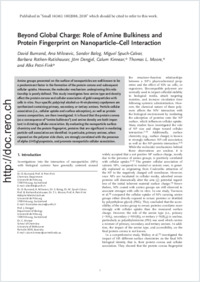Beyond global charge: role of amine bulkiness and protein fingerprint on nanoparticle–cell interaction
- Burnand, David Chemistry Department, University of Fribourg, Switzerland - Adolphe Merkle Institute, University of Fribourg, Switzerland
- Milosevic, Ana Adolphe Merkle Institute, University of Fribourg, Switzerland
- Balog, Sandor Adolphe Merkle Institute, University of Fribourg, Switzerland
- Spuch-Calvar, Miguel Adolphe Merkle Institute, University of Fribourg, Switzerland
- Rothen-Rutishauser, Barbara Adolphe Merkle Institute, University of Fribourg, Switzerland
- Dengjel, Jörn Department of Biology, University of Fribourg, Switzerland
- Kinnear, Calum School of Chemistry, University of Melbourne, Parkville, Australia
- Moore, Thomas L. Adolphe Merkle Institute, University of Fribourg, Switzerland
- Petri-Fink, Alke Chemistry Department, University of Fribourg, Switzerland - Adolphe Merkle Institute, University of Fribourg, Switzerland
-
2018
Published in:
- Small. - 2018, vol. 14, no. 46, p. 1802088
English
Amino groups presented on the surface of nanoparticles are well‐known to be a predominant factor in the formation of the protein corona and subsequent cellular uptake. However, the molecular mechanism underpinning this relationship is poorly defined. This study investigates how amine type and density affect the protein corona and cellular association of gold nanoparticles with cells in vitro. Four specific poly(vinyl alcohol‐co‐N‐vinylamine) copolymers are synthesized containing primary, secondary, or tertiary amines. Particle cellular association (i.e., cellular uptake and surface adsorption), as well as protein corona composition, are then investigated. It is found that the protein corona (as a consequence of “amine bulkiness”) and amine density are both important in dictating cellular association. By evaluating the nanoparticle surface chemistry and the protein fingerprint, proteins that are significant in mediating particle–cell association are identified. In particular, primary amines, when exposed on the polymer side chain, are strongly correlated with the presence of alpha‐2‐HS‐ glycoprotein, and promote nanoparticle cellular association.
- Faculty
- Faculté des sciences et de médecine
- Department
- Département de Biologie, Département de Chimie, AMI - Bio-Nanomatériaux
- Language
-
- English
- Classification
- Chemistry
- License
-
License undefined
- Identifiers
-
- RERO DOC 323821
- DOI 10.1002/smll.201802088
- Persistent URL
- https://folia.unifr.ch/unifr/documents/307368
Other files
Statistics
Document views: 146
File downloads:
- pdf: 151
- Supplementary material: 191

